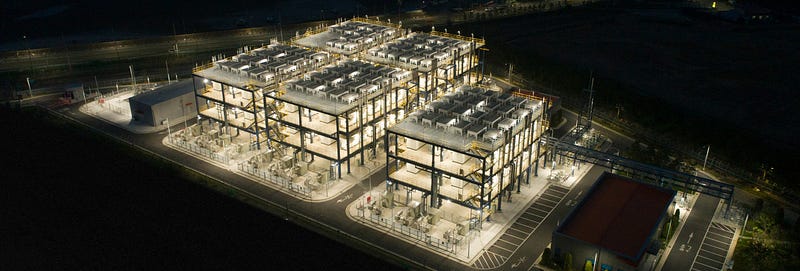Hydrogen: The Promising Future of Clean Energy Solutions
Written on
Chapter 1: The Potential of Hydrogen Energy
Hydrogen, the most abundant element in the universe, holds significant promise for transforming our energy landscape. A power facility that opened recently in South Korea demonstrates this potential by utilizing leftover hydrogen from oil production to generate electricity.

Over 90% of the universe is composed of hydrogen, which fuels the largest ocean in our Solar System — a massive sea of liquid metallic hydrogen hidden beneath Jupiter's turbulent atmosphere. While we can't recreate the extreme conditions needed for liquid metallic hydrogen on Earth, we do have access to its gaseous and liquid states. Annually, around 70 million metric tons of hydrogen are utilized across various industries, including chemicals, fertilizers, food processing, and oil refining.
However, hydrogen is set to extend its influence far beyond these applications, promising to revolutionize home energy usage and mitigate our environmental footprint. A 2017 survey revealed that over 75% of automotive executives believe that the future breakthroughs in electric vehicles will stem not from battery-powered cars, like Teslas, but from hydrogen fuel cell technology. By 2030, hydrogen energy could evolve into a $140 billion sector, creating over 700,000 jobs.
What drives this optimism around hydrogen as a future energy source?
Section 1.1: Hydrogen's Energy Efficiency
When comparing hydrogen to traditional fossil fuels, it becomes apparent why hydrogen is seen as a game-changer. Hydrogen provides three times more energy per pound than diesel or gasoline, making it essential for industries like aviation, steel manufacturing, and shipping that require high-energy fuels. These sectors also need to fuel furnaces that can exceed temperatures of 2,732 degrees Fahrenheit (1,500 degrees Celsius). Current fossil fuel processes produce substantial carbon emissions, but substituting hydrogen for coal in steel production can convert harmful CO2 emissions into harmless water vapor. Our long history with hydrogen also equips us with the knowledge to manage and transport it effectively, and it is capable of being stored for extended periods.
Thus, hydrogen presents a clean energy solution, with water as its only byproduct. This makes it a pivotal component of a decarbonized future, even in sectors where integrating clean energy poses challenges.

Section 1.2: Fuel Cells vs. Battery Electric Vehicles
Hydrogen can serve as an alternative to battery electric vehicles (BEVs) when utilized in fuel cells. While BEVs store electrical energy via lithium-ion batteries, fuel cell electric vehicles (FCEVs) generate electricity through reactions between hydrogen and oxygen. This process produces electricity along with water and warm air as emissions.
Filling up a hydrogen car takes only about five minutes at dedicated fueling stations, contrasting sharply with the extended charging times required for BEVs. FCEVs are also 2-3 times more efficient than gasoline vehicles and can travel over 300 miles on a single fill-up. This combination of established technology and innovation positions fuel cell vehicles to potentially dominate the market, especially for heavier transportation like trucks and ships.
Chapter 2: The Challenges of Hydrogen Production
Despite hydrogen's promise, its current production methods pose significant challenges. Most hydrogen is produced through a process called steam methane reforming, which combines natural gas with steam at high temperatures. This method is energy-intensive and generates considerable CO2 emissions. The production of gray hydrogen, derived from fossil fuels, contributes to approximately 830 million metric tons of carbon emissions annually. By capturing and storing the carbon, this can be classified as blue hydrogen.
The ultimate goal is to produce green hydrogen, which is created through electrolysis — a process that uses renewable electricity to separate hydrogen from oxygen in water. Unfortunately, this method is currently three times more expensive than gray hydrogen, averaging between $2.50 and $4.50 per kilogram, while competing gray hydrogen costs around $1 per kilogram. However, as renewable energy sources become cheaper and hydrogen infrastructure expands, the cost of green hydrogen is expected to decline.

The US Department of Energy is investing $100 million in hydrogen energy research, while the European Union is planning an even larger investment of $430 billion by 2030. China aims to have one million FCEVs operational by then, with its hydrogen energy sector projected to reach $155 billion by 2025. Other countries, including Australia, Japan, and South Korea, are also committing substantial funds to hydrogen technology. South Korea, for instance, envisions six of its cities primarily powered by hydrogen by 2025.
The development of an emissions-free, versatile energy source based on hydrogen could significantly benefit humanity. Green hydrogen has applications across various sectors, from transportation to manufacturing, while reducing our environmental impact. However, transitioning from traditional energy sources like gas and coal to hydrogen will require time and infrastructure development. As our population grows and energy demands increase, the need for abundant, clean energy solutions becomes more pressing.
The first video titled "Is Nuclear Fusion the Future of Clean Energy?" explores the possibilities of nuclear fusion as a sustainable energy source.
The second video, "The Future of Energy: Nuclear Power," discusses the evolving role of nuclear energy in the global energy landscape.